Related Research Articles
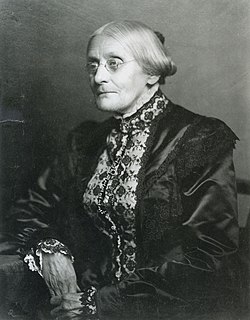
Susan B. Anthony was an American social reformer and women's rights activist who played a pivotal role in the women's suffrage movement. Born into a Quaker family committed to social equality, she collected anti-slavery petitions at the age of 17. In 1856, she became the New York state agent for the American Anti-Slavery Society.

Elizabeth Cady Stanton was a leader of the women's rights movement in the U.S. during the mid- to late-1800s. She was the main force behind the 1848 Seneca Falls Convention, the first convention to be called for the sole purpose of discussing women's rights, and was the primary author of its Declaration of Sentiments. Her demand for women's right to vote generated a controversy at the convention but quickly became a central tenet of the women's movement. She was also active in other social reform activities, especially abolitionism.

The National Woman Suffrage Association (NWSA) was formed on May 15, 1869 to work for women's suffrage in the United States. Its main leaders were Susan B. Anthony and Elizabeth Cady Stanton. It was created after the women's rights movement split over the proposed Fifteenth Amendment to the U. S. Constitution, which would in effect extend voting rights to black men. One wing of the movement supported the amendment while the other, the wing that formed the NWSA, opposed it, insisting that voting rights be extended to all women and all African Americans at the same time.

Matilda Joslyn Gage was a women's suffragist, Native American rights activist, abolitionist, freethinker, and author. She is the eponym for the Matilda Effect, which describes the tendency to deny women credit for scientific invention.
The Revolution was a newspaper established by women's rights activists Susan B. Anthony and Elizabeth Cady Stanton in New York City. It was published weekly between January 8, 1868 and February 17, 1872. With a combative style that matched its name, it primarily focused on women's rights, especially prohibiting discrimination against women voting, women's suffrage. It also covered other topics, however, such as politics, the labor movement and finance. Anthony managed the business aspects of the paper while Stanton was co-editor along with Parker Pillsbury, an abolitionist and a supporter of women's rights.

Paulina Kellogg Wright Davis was an American abolitionist, suffragist, and educator. She was one of the founders of the New England Woman Suffrage Association.
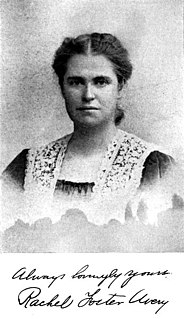
Rachel Foster Avery was active in the American women's suffrage movement during the late 19th century, working closely with Susan B. Anthony and other movement leaders. She rose to be corresponding secretary of the National American Woman Suffrage Association and played a key role in organizing meetings across the country.

The legal right of women to vote was established in the United States over the course of more than half a century, first in various states and localities, sometimes on a limited basis, and then nationally in 1920.

The Women's Loyal National League, also known as the Woman's National Loyal League and other variations of that name, was formed on May 14, 1863, to campaign for an amendment to the U.S. Constitution that would abolish slavery. It was organized by Elizabeth Cady Stanton, its president, and Susan B. Anthony, its secretary. In the largest petition drive in the nation's history up to that time, the League collected nearly 400,000 signatures on petitions to abolish slavery and presented them to Congress. Its petition drive significantly assisted the passage of the Thirteenth Amendment, which ended slavery in the U.S. The League disbanded in August 1864 after it became clear that the amendment would be approved.

Lucretia Mott was a U.S. Quaker, abolitionist, women's rights activist, and social reformer. She had formed the idea of reforming the position of women in society when she was amongst the women excluded from the World Anti-Slavery Convention in 1840. In 1848 she was invited by Jane Hunt to a meeting that led to the first meeting about women's rights. Mott helped write the Declaration of Sentiments during the 1848 Seneca Falls Convention.

The American Equal Rights Association (AERA) was formed in 1866 in the United States. According to its constitution, its purpose was "to secure Equal Rights to all American citizens, especially the right of suffrage, irrespective of race, color or sex." Some of the more prominent reform activists of that time were members, including women and men, blacks and whites.
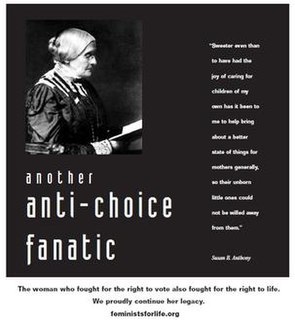
Susan B. Anthony was a leader of the American women's suffrage movement whose position on abortion has been the subject of a modern-day dispute. The dispute has primarily been between anti-abortion activists, who say that Anthony expressed opposition to abortion, and acknowledged authorities in her life and work who say that she did not.

The New England Woman Suffrage Association (NEWSA) was established in November 1868 to campaign for the right of women to vote in the U.S. Its principal leaders were Julia Ward Howe, its first president, and Lucy Stone, who later became president. It was active until 1920, when suffrage for women was secured by the Nineteenth Amendment to the U.S. Constitution.
Laura Curtis Bullard (1831–1912) was an American writer and women's rights activist. She founded a newspaper called The Ladies' Visitor, and Drawing Room Companion and published two novels with women's rights themes, the best known of which is Christine: or, Woman's Trials and Triumphs. She was elected as a corresponding secretary for the National Woman Suffrage Association, led by Elizabeth Cady Stanton and Susan B. Anthony, at its founding meeting. She succeeded Stanton as editor of The Revolution, a women's rights newspaper founded by Stanton and Anthony.
The Working Women's Association (WWA) was formed in New York City on September 17, 1868 in the offices of The Revolution, a women's rights newspaper established earlier that year by Elizabeth Cady Stanton and Susan B. Anthony. Its stated purpose was to create "an association of working-women which might act for the interests of its members, in the same manner as the associations of workingmen now regulate the wages, etc., of those belonging to them." Shortly afterwards Anthony was seated as a delegate of the WWA at the annual congress of the National Labor Union (NLU), the first national labor federation in the U.S.
History of Woman Suffrage is a book that was produced by Elizabeth Cady Stanton, Susan B. Anthony, Matilda Joslyn Gage and Ida Husted Harper. Published in six volumes from 1881 to 1922, it is a history of the women's suffrage movement, primarily in the United States. Its more than 5700 pages are the major source for primary documentation about the women's suffrage movement from its beginnings through the ratification of the Nineteenth Amendment to the U.S. Constitution, which enfranchised women in the U.S. in 1920. Written from the viewpoint of the wing of the movement led by Stanton and Anthony, its coverage of rival groups and individuals is limited.

The Rochester Women's Rights Convention of 1848 met on August 2, 1848 in Rochester, New York. Many of its organizers had participated in the Seneca Falls Convention, the first women's rights convention, two weeks earlier in Seneca Falls, a smaller town not far away. The Rochester convention elected a woman, Abigail Bush, as its presiding officer, making it the first public meeting composed of both men and women in the U.S. to do so. This controversial step was opposed even by some of the meeting's leading participants. The convention approved the Declaration of Sentiments that had first been introduced at the Seneca Falls Convention, including the controversial call for women's right to vote. It also discussed the rights of working women and took steps that led to the formation of a local organization to support those rights.
The Ohio Women's Convention at Salem in 1850 met on April 19–20, 1850 in Salem, Ohio, a center for reform activity. It was the third in a series of women's rights conventions that began with the Seneca Falls Convention of 1848. It was the first of these conventions to be organized on a statewide basis. About five hundred people attended. All of the convention's officers were women. Men were not allowed to vote, sit on the platform or speak during the convention. The convention sent a memorial to the convention that was preparing a new Ohio state constitution, asking it to provide for women's right to vote.
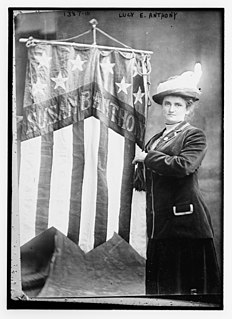
Lucy Elmina Anthony was an internationally known leader in the Woman's Suffrage movement. She was the niece of American social reformer and women's rights activist Susan B. Anthony and longtime companion of women's suffrage leader Anna Howard Shaw.
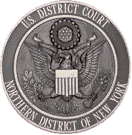
United States v. Susan B. Anthony was the criminal trial of Susan B. Anthony in a U.S. federal court in 1873. The defendant was a leader of the women's suffrage movement who was arrested for voting in Rochester, New York in the 1872 elections in violation of state laws that allowed only men to vote. Anthony argued that she had the right to vote because of the recently adopted Fourteenth Amendment to the U.S. Constitution, part of which reads, "No State shall make or enforce any law which shall abridge the privileges or immunities of citizens of the United States."
References
- ↑ Some contemporary newspaper accounts spelled her name as Vaughn and others as Vaughan, and the same is true of academic studies. The Philadelphia Inquirer, which covered the trial itself, used Vaughn. The Revolution, which afterwards conducted a campaign in her defense, used Vaughan. The New York Times article on the mass meeting in her defense used Vaughn except when quoting directly from resolutions passed by the meeting, which used Vaughan.
- 1 2 Gordon, Sarah Barringer (2002). "Law and Everyday Death: Infanticide and the Backlash against Woman's Rights after the Civil War" (PDF). In Sarat, Austin; Douglas, Lawrence; Umphrey, Martha (eds.). Lives in the Law. University of Michigan Press. pp. 55-56. ISBN 0-472-11253-8.
- ↑ This outline of Vaughn's story comes from footnotes by Ann D. Gordon to an article called "Infanticide" in The Revolution, August 6, 1868, p. 74, which is reprinted in Gordon (2000), pp. 158–159. Contemporary sources provide other variations of this story, but they are often contradictory. For example, one version says that the man who impregnated Vaughn was her employer, while another says that she refused to identify him.
- ↑ Philadelphia Inquirer, July 1, 1868, p. 2, under the heading "Legal Intelligence." The conclusion of this trial is reported in the same newspaper on page 3 of the issue for July 2 beneath the same heading. These digitized newspaper images are produced by the Fultonhistory.com service.
- 1 2 3 4 "The Case of Hester Vaughan," The Revolution, December 10, 1868, pp. 357–358.
- ↑ "Infanticide", The Revolution, August 6, 1868, p. 74, which is reprinted in Gordon (2000), pp. 158–159.
- 1 2 "Hester Vaughn", New York Times, December 2, 1868
- ↑ "The Termagants and the Slaughter of the Innocents", Rochester Union and Advertiser, December 3, 1868, p. 3. This quote also appears in the New York World, December 2, 1868, according to Sherr (1995), p. 218.
- ↑ Balser, Diane (1987). Sisterhood & Solidarity: Feminism and Labor in Modern Times . South End Press. pp. 65. ISBN 9780896082779.
- ↑ "The Case of Hester Vaughn", New York Evening Telegram, Dec 2, 1868, p. 2
- ↑ The Nation, Dec 10, 1868, "Women as Politicians," pp. 475–476
- ↑ DuBois (1978), p. 145–147
- ↑ "Hester Vaughan in England Sick and Destitute". New York Times. June 25, 1869.
- ↑ Gordon, Ann D., ed. (2003). The Selected Papers of Elizabeth Cady Stanton and Susan B. Anthony: National Protection for National Citizens, 1873 to 1880, p. 235. Vol. 3 of 6. New Brunswick, NJ: Rutgers University Press. ISBN 0-8135-2319-2.
- ↑ Gordon, Sarah Barringer (2002). "Law and Everyday Death: Infanticide and the Backlash against Woman's Rights after the Civil War" (PDF). In Sarat, Austin; Douglas, Lawrence; Umphrey, Martha (eds.). Lives in the Law. University of Michigan Press. pp. 76. ISBN 0-472-11253-8.